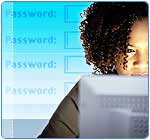Passwords are the keys you use to access personal information saved on your computer and in your online accounts.
 If hackers or other malicious users steal this information, they can use your name to open a credit card account in your name. In many cases, you might not notice these attacks until it’s too late. However, creating a strong password and protecting it is not difficult.
If hackers or other malicious users steal this information, they can use your name to open a credit card account in your name. In many cases, you might not notice these attacks until it’s too late. However, creating a strong password and protecting it is not difficult.
How to Create a Strong Password
For an attacker, a strong password should consist of a string of random characters. The following standards can help your password achieve that:
Increase Length. Each character you add to your password increases its security; it should be more than 8 characters long, with 14 characters or more being ideal.
Many systems also support the use of spaces in passwords, allowing you to create a passphrase formed by multiple words. A passphrase is often easier to remember than a single password, provided it is longer and harder to guess.
Mix Characters, Numbers, and Symbols. The diversity of characters in your password will make it harder to guess. Important features include:
– Types of characters and the length they should have in your password. A string of 15 characters made up of random letters and numbers will give you a password that is approximately 33,000 times stronger than an 8-character password from the keyboard. If you cannot include symbols in your password, you must make it significantly longer to achieve a similar level of protection. An ideal password combines both length and various types of symbols.
– Use the entire keyboard, not just common characters. Symbols accessed by holding the “Shift” key to get the upper characters of a key are very common in passwords.
Use Memorable Yet Hard-to-Guess Words and Phrases. The best way to remember your password and phrases is to write them down. There is nothing wrong with writing your passwords down, but they need to be protected to ensure safety and effectiveness.
Create a Safe and Memorable Password in 6 Steps:
1. Think of a sentence that you can remember. For example: “My son Aiden is three years old”
2. Check if your computer or online systems support spaces.
3. If your computer or online systems do not support spaces, convert it into a password by taking the first letters of each word in the sentence. Using the example above, you would create “msaityo”.
4. Add complexity by mixing uppercase letters, lowercase letters, and numbers.
5. Finally, replace a few characters with special symbols. You can use symbols that resemble letters, combine words (to replace spaces), and other methods to make your password more complex.
6. Check your password with Password Checker. Password Checker is a website that does not log any information and helps you determine the security of your password.
A Few Points to Avoid with Passwords
There are several methods used to create passwords that are easily guessed by criminals. To avoid these vulnerabilities, we must steer clear of the following:
-
Avoid sequences or repeating characters: for example 123456, 2222
-
Avoid using similar substitutions between letters and numbers: for example replacing i → 1 or a → @
-
Avoid your username
-
Avoid dictionary words in any language
-
Use more than one password everywhere
-
Avoid using online storage
The Option of a “Blank Password”
A “blank password” (no password) on your account is safer than weak passwords like “1234”. Criminals can easily guess a simple password, but on computers using Windows XP, an account without a password cannot be accessed remotely by a local network or over the Internet (These options are not available for Microsoft Windows 2000, Windows Me, etc.). You can choose to use a “blank password” on your computer account if your computer meets the following criteria:
-
You have only one computer or you have several computers but do not need to access information from one to another.
-
The computer must be physically secure (you must trust that everyone has physical access to the computer).
Using a “blank password” is not always a good idea. For example, a laptop you carry with you may not be physically secure, so you should have a strong password.
How to Access and Change Your Password
Online Accounts
Websites have different terms that govern how you can access or change your password. You will need to find a link (such as “My Account”) on the homepage to reach the special page used to manage your passwords and account.
Computer Passwords
Help files for your computer system often provide information on creating, changing, and accessing password-protected user accounts. You can try to find this information online on the websites of software manufacturers. For example, if you are using Windows XP, the support section may show you how to manage passwords, change passwords.
Keep Your Passwords Secret
Be very careful with your passwords and passphrases.
-
Do not disclose them to others. Keep your passwords hidden from your friends and family members (especially children). The passwords that you need to share with others, such as your banking account password that you might share with your spouse, are exceptions.
-
Protect any written passwords. Be careful where you hide the password you have written down.
-
Never provide your password via email or rely on an email request.
-
Change your password regularly.
-
Do not type your password on a computer you do not control.
What to Do If Your Password is Stolen
Make sure to check all information you protect with a password, such as your monthly financial statements, credit reports, online shopping accounts… Good, memorable passwords can help you guard against fraud and identify thieves without protections. If someone breaks into the system and steals this information from you, they will have your password. If you notice any suspicious activity indicating someone is accessing your information, notify experts immediately if you can. For more information, visit “what to do” if you believe your identity has been stolen or if you think you may be a victim of fraud.
Pham Van Linh(According to Microsoft)
Email: [email protected]


















































